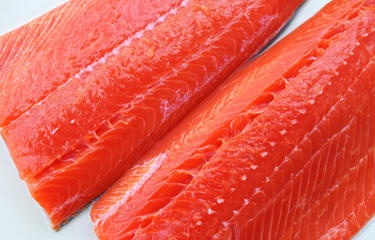Retail prices for sockeye salmon have been at historical highs for the past three months, largely driven by a 25 percent drop in global supply in 2020.
For Q1 up through 27 January, wild sockeye salmon fillets averaged USD 12.07 (EU 10.05), the highest quarterly average since 2012, according to figures cited by the Bristol Bay Regional Seafood Development Association (BBRSDA).
BBRSDA Executive Director Andy Wink said sockeye prices have spiked higher during the boreal summer, when the fresh market is being fed by fisheries in Alaska, Russia, and Japan, but these are the highest prices recorded for the winter months.
“Retail prices are at or above record levels, at least for this time of year. It’s not like we’ve never had sockeye prices this high, it’s just that we’ve never had them this high at this point in the year,” Wink told SeafoodSource, confirming that November, December, and January broke records.
Last season, global sockeye supply dipped to 298 million pounds, around 25 percent below the previous five-year average of 394 million pounds. Bristol Bay provided 66 percent of the global catch last season with 196 million pounds, while Alaska’s statewide contribution was 226 million pounds. Russia managed just 67 million pounds of sockeye after turning in closer to 100 million pounds annually over the five previous years.
Wink said low supply is part of what is driving high prices, but it does not tell the whole story.
“I think the pandemic pushed more people toward retail, resulting in more demand than less, at least for sockeye. I think marketing and the awareness of Bristol Bay, the demand for the fish as a product, people wanting to eat healthy – all these things have contributed,” Wink told SeafoodSource.
As prices for wild-caught salmon have risen, farmed salmon prices have dropped. Most recent quarterly prices for farmed Atlantic salmon fillets sat at USD 6.99 (EU 5.82), the lowest price registered since Q1 2016 and a steep drop from early 2020, when farmed prices were USD 8.80 (EU 7.33). Over the past decade, the gap between farmed and fresh fillets hovered more in the range of USD 2.00 to USD 3.00 (EUR 1.66 to EUR 2.50) and had not exceeded USD 4.00 (EUR 3.33) until Q2 of 2020. The current gap of over USD 5.00 (EU 4.16) will be a source of handwringing as the 2021 season unfolds.
“We’ll see how long that gap holds in there. It got pretty big in 2014 and 2015 and the [wild] price came crashing down. It’s a competing product that’s a lot cheaper, and we don’t have exact numbers on how many of our customers are only going to buy wild sockeye, or how many are price sensitive,” Wink said.
Along with other factors, a gap of nearly USD 4.00 (EUR 3.33) in Q2 2014 between wild sockeye and Atlantic farmed fillets contributed to cratering ex-vessel prices in Bristol Bay, which fell from USD 1.20 (EUR 1.00) in 2014 to USD 0.50 (EUR 0.42) in 2105.
Dan Lesh, a consultant with McKinley Research Group, said there is a point where farmed fish will undermine the high wild-caught salmon prices.
“Farmed salmon and wild salmon compete but they aren’t perfect substitutes. What you’re seeing right now is there’s not enough supply to meet the demand for wild salmon, but at some volume and certain price differentials that farmed salmon competition kicks in,” Lesh told SeafoodSource.
According to McKinley Research, the pandemic pushed farmed salmon prices down to six-year lows in 2020. And while farmed prices crept up toward the end of January, that might not last. Lesh said the pandemic prompted Chilean producers to freeze large amounts of farmed salmon that would have normally hit the fresh market.
Now, farmed salmon producer Mowi estimates Chilean freezers are stuffed with around 55,000 to 65,000 metric tons that will hit the market at some point this year, a glut that could drive down farmed prices again, and drag the prices of wild-caught salmon as well.
“The farmed salmon competition story is not going away this year,” Lesh said.
And the pandemic will continue to inject its special brand of uncertainty into the market, Lesh said. McKinley has reported that industry insiders believe COVID-19 complications will likely be worse in the upcoming summer salmon season than they were last year.
“Companies were able to establish controls to limit outside exposure, and outbreak levels nationally and in Alaska were at far lower levels in the lead-up to the state’s salmon season than is presently the case,” a report McKinley recently prepared for the Alaska Seafood Marketing Institute (ASMI) said.
Recent COVID-19 outbreaks in plants that process winter Bering Sea harvests like pollock and crab do not bode well for fisheries like Bristol Bay, where processors often struggle to keep pace with catch even under normal circumstances.
Photo courtesy of BeeRu/Shutterstock







